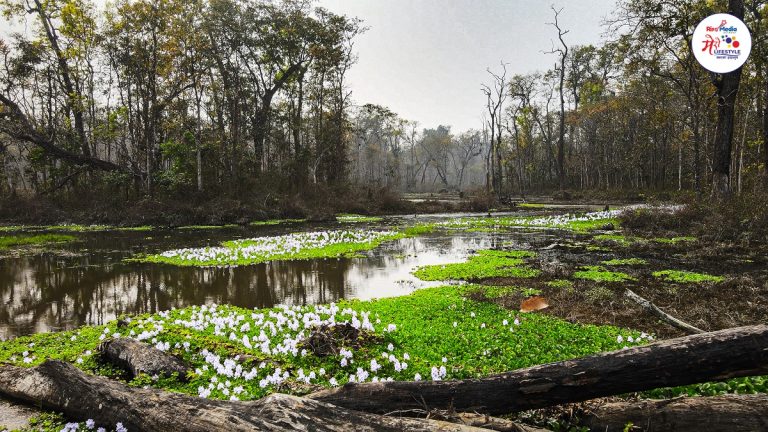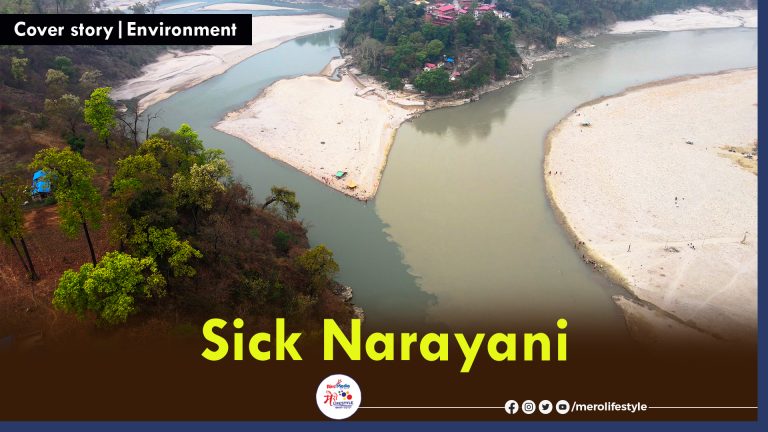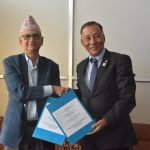Giving a New Lease of Life to Wetlands

Until the early 1990s, long-distance migratory birds from places far away as Siberia used to flock to the Tikauli Forest in Chitwan. The lakes, ponds and rivers in the jungle area were perfect sources for the birds to get food and water. In the lush green forest, they would look for places to lay eggs and raise their hatchlings and chicks. Then, after some time they would return to their native Siberia. However, the wetlands started to disappear, Siberian birds stopped coming to the Tikauli Forest as they probably migrated to other places in search of breeding grounds.
The water sources of the human settlements adjacent to the Tikauli Forest dried up. Due to the drought, most of the fields were without crops. Though the settlements are adjacent to the forest, the locals had to dig 25 to 30 feet deeper wells to find water.
However, fortunately this is now a story of the past because the situation in Tikauli and its surrounding areas have changed noticeably.
The long-distance migratory Siberian birds are once again making Tikauli their destination. Other wild animals in the forest are also able to quench their thirst with ease. The forest is lush green and the soil of the fields near it has again become fertile. Not only that, the groundwater can now be found at 10 to 15 feet below the surface of the settlements.

These changes have not just benefited wildlife and forests, but it has also brought significant transformation into the lives of people of Tikauli. But how did this almost ‘magical’ change become possible in Tikauli ?
In fact, it is not magic. It is just a result of conscious effort towards the conservation of the wetland.
Wetlands or swampy areas are sources of water and are an important natural site providing shelter to various species of animals and plants. Also, the wetlands are the source of livelihood for people who live near these swampy areas.

Considering these benefits, the Tikauli Buffer Zone Community Forest Users Committee started a campaign to protect and conserve the wetland area with active support from organizations including the World Wildlife Fund for Nature Nepal (WWF Nepal). The organizations encouraged and helped the villagers to conserve the wetland. As a result, there are currently eight wetland areas within the forest. The committee has estimated that the wetlands will store more than 900 million liters of water.
The increase in water storage areas in the wetlands has turned the grasslands green which has directly benefitted the consumers of forests products as well .
The Changes in People’s Lives
Due to the increase of water in the wetlands, the Tikauli forest now looks lush green. Ishwori Prasad Lamichhane, Chairperson of the Tikauli Buffer Zone Community Forest Users Committee, says that this has brought a lot of relief to the wild animals and birds that used to wander anxiously in search of water in the past. “The increase in water storage areas in the wetlands has turned the grasslands green which has directly benefitted the consumers of forests products as well,” said Lamichhane.
The community forest users committee has connected the locals with a cooperative institution which has helped the people to strengthen themselves financially. “Many working-class people who had the mentality of spending their daily earnings are now into savings,” said Lamichhane, referring to the benefits of the changes seen in the wetlands. Locals of Tikauli go to the forest to collect fiddlehead ferns to sell in the vegetable market. “We can see the happiness on the faces of the people when they deposit their hard-earned money into the savings at the cooperative institution,” he said. Thanks to the wetlands of Tikauli Forest that have brought joy to the lives of the people.
Lamichhane confirms that with the revival of wetland areas, birds and other wildlife have started to flock to the lakes and ponds. “Earlier, when the wetland areas were disappearing, the animals stopped coming to this area,” he said, adding, “With the wetlands now revived, different types of birds and animals have started returning to the forest. Among them, Ruddy Shelduck birds are seen swimming in the ponds on a daily basis.” According to Lamichhane, the number of tourists visiting Tikauli to watch the birds and animals is also rising who buy tickets to go for a walk in the forest. “We charge Rs 50 per ticket for domestic tourists while the rate is Rs 200 for foreigners,” he informed. “Last year, the Tikauli Buffer Zone Community Forest Users Committee earned Rs 15 million from ticket sales.”
Moreover, but the committee is also engaged in fish farming in the wetland areas. According to Lamichhane, fish worth Rs 15 million was sold last year. He shared that a part of income was spent on providing skills-oriented training such as vehicle driving training, and educational excursions for the youth of poor families.

As a result of the conservation of the wetlands, animals including crocodiles, python, tigers, bears, rhinos, elephants, wild boars and spotted dears have started to significantly appear in the forest and tourists visiting the jungle area get happy on getting a chance to observe this wildlife closely.
We have started the construction of Dhabah Wetlands Conservation Lake,The lake will be a major source of water for wildlife in the forest as well as for irrigation to the people living in the lower areas. The water in the lake can be purified to supply drinking water to the people if necessary.
Not only in Tikauli but wetlands are also being revived in many forests in and around the Chitwan district as people are beginning to realize the benefits of the conservation of wetland areas. For instance, the Nawalparasi Nandan Community Forest Users Group is also involved in the protection of wetland areas. According to Kamala Sharma, Secretary of the group, a lake is being built with financial assistance from WWF Nepal and technical assistance from Sahamati, a non-governmental organization working on community development. “We have started the construction of Dhabah Wetlands Conservation Lake,” said Sharma, adding, “The lake will be a major source of water for wildlife in the forest as well as for irrigation to the people living in the lower areas.” According to her, the water in the lake can be purified to supply drinking water to the people if necessary.
These are a few examples of the conservation of wetlands.
Wetlands: The Ecological Shields
There is another side to the coin while talking about the benefits of the wetlands. Many wetland areas across Nepal are disappearing at present. “Excessive use of the swamps, encroachment of land and lack of conservation of water sources have added challenges to the conservation and management of wetlands,” said Dr. Ramchandra Kandel, Director General of the Department of National Parks and Wildlife Conservation under the Ministry of Forests and Environment. “The wetlands are also drying up due to the global climate change. So, considering all these things, we’ve come ahead with different programs for the conservation of wetlands.”
Besides environmental protection, wetlands are also important places for tourism development as visitors go to such locations to experience the natural beauty of flora and fauna and for activities such as swimming and boating.
Dr. Kandel views wetlands as important to face the challenges posed by climate change. “These areas provide environmental protection by mitigating the impacts of climate change acting as ecological shields,” he said, adding, “Besides environmental protection, wetlands are also important places for tourism development as visitors go to such locations to experience the natural beauty of flora and fauna and for activities such as swimming and boating.”
626 Wetlands Across Nepal
There are many wetlands of international importance in the Terai, hills and mountainous regions of Nepal. According to a report published by the National Lake Conservation Development Committee in February 2021, there are 626 wetland areas across the country up to 3,000 meters above sea level.
Wetlands are important habitats for hundreds of thousands of migratory birds, fish, amphibian animals, insects and plants. According to the statistics of the department, 172 endangered species of plants and animals found in Nepal are dependent on wetlands for survival. “Out of 878 species of birds found in Nepal, 193 species of birds, 17 out of 20 species of vertebrates, 25 percent of 7,000 species of plants and 246 native flowering species are dependent on wetlands,” informed Dr. Kandel.
We are assisting in wetland conservation for different purposes in different places,we aim to make water available for wildlife in some places, whereas it is for expanding irrigation facilities for the locals, conservation of water resources and biodiversity, and to mitigate the risks of floods in other places. Overall, we seek to recharge the groundwater by conserving the wetlands.
WWF Nepal, which is supporting the local communities in the conservation of the wetlands is focusing on replenishing the water in the swamps. According to Rajesh Sada, Head of Freshwater Program at WWF Nepal, their main aim is to recharge the groundwater. “We are assisting in wetland conservation for different purposes in different places,” he said. “For instance, we aim to make water available for wildlife in some places, whereas it is for expanding irrigation facilities for the locals, conservation of water resources and biodiversity, and to mitigate the risks of floods in other places. Overall, we seek to recharge the groundwater by conserving the wetlands.”
Wetlands are sources of water,Special attention should be given to conservation of the water resources for groundwater recharge .The government should also focus on reviving lakes and ponds that need conservation .
This is indeed good news.
Sada also shared another good news in this context. “WWF Nepal is working on wetland construction and conservation in the Terai region in districts including Chitwan, Nawalparasi, Lumbini, Dang, Kailali and Kanchanpur,” he said.

The initiatives of organizations like WWF Nepal have encouraged local governments and authorities to join hands in the conservation of wetlands. However, Dr. Ghanshyam Gurung, Country Representative of WWF Nepal says this is not sufficient. “Wetlands are sources of water,” he said, adding, “Special attention should be given to conservation of the water resources for groundwater recharge.” He suggested that the government should take steps to protect the wetland and create new wetland areas. “The government should also focus on reviving lakes and ponds that need conservation,” he urged.
Of course, if the neglected lake and ponds are to be given a new lease of life, not only aquatic and terrestrial animals but also plants will be able to survive. It has become necessary also because wetlands are a boon for the lives of the locals and for tourism activities.
The discourses and initiatives related to the conservation of the wetlands and creating new swamp areas are like ‘preserving a hen that lays golden eggs’. The big question here is whether to sow seeds of consciousness to preserve these important water resources or let the wetlands disappear. The decision is in our hands.
Photo courtesy : WWF Nepal
Video Link :









